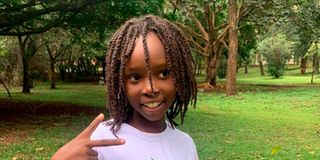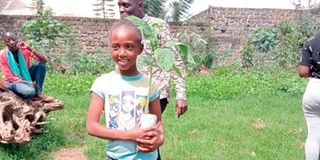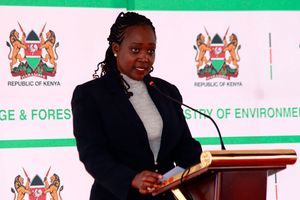Generation restoration: Young champions saving Mother Earth

Ivory Wanjala, 9, has been leading tree growing campaigns in Kiambu County since she was five years old.
What you need to know:
- Children are mostly caught up in the frivolities of being a child, but these three young girls are taking up environmental consciousness to another level.
- They are securing the future for themselves and those who will come after them.
Children are mostly caught up in the frivolities of being a child, but these three young girls are taking up environmental consciousness to another level, securing the future for themselves and those who will come after them. Healthy Nation spoke with Ivory Wanjala, 9, Aisha Chai 8 and Mellisa Njeri, 11 on their individual journeys championing the repair of Mother Nature.
Ivory Wanjala, 9. Environmentalist (tree growing campaigner )
My interest in the environment began when I was five years old. I began noticing how dirty streets and rivers were on television and I wanted to change that by doing something to make my country cleaner and better.
I love that President William Ruto has asked every Kenyan to plant trees. My environmental campaign is founded on tree growing. I am glad people are realising the importance of greening the environment.
In the previous rainy season, with the help of my family, we planted 1,200 trees out of which more than 1,000 have survived. My target is to triple that number and plant 3,000 trees in the next rainy season.
My campaign targets children and I always involve my peers whenever I am out planting trees. I do it in schools and churches and I always make sure that the children look after the trees after we have concluded the exercise. I do this by assigning a tree or two per child, this way, children are able to understand the importance of taking care of the environment.
I look up to the late Nobel Laureate Wangari Maathai. She is the inspiration to my humming bird moniker. I don’t see myself just as helpless child with nothing to offer the world; instead I see myself as the humming bird that is willing to make a difference by doing what I can to solve some of the challenges we are facing due to environmental degradation. I dream of a Kenya where everyone will be conscious of the environment. Many people do not realise how bad our climate situation is, and that humans are the main cause of these problems. Scientists say that if humans continue with their current habits such as cutting trees, air pollution by cars and factories, the effects of climate change will be irreversible.
The environment is so much more than trees. We have a problem with solid waste management as a country. For example, there is no proper waste management in big cities like Nairobi. There is also a lot of waste food that is left in open air, producing greenhouse gases like methane that contribute to climate change.
I am currently running a project of reducing food waste through vermin composting. I am showing people how they can use rede worms to make organic fertilisers instead of relying on chemicals to grow food. I will keep doing my best and calling for more people to do the same. You can follow my work on eco.ivory.org, where you can find more information on the environment.
Aisha Chai, 8. Environmental activist (plastic pollution)
I started noticing there was a problem with the environment when I was six years old and in grade one.

Aisha Chai, 8, is an environmentalist from Nakuru County. She has been creating awareness on plastic pollution.
My specific interest is plastic pollution. I was excited that this year’s World Environment Day theme was on beating plastic pollution. On that day, I engaged in a social media campaign to create awareness so that children my age could understand what plastic pollution is.
There are lots of plastics in the environment and this poses a danger to both humans and animals. Plastic pollution is caused by single use plastics that you use once and throw away.
Plastics are non-biodegradable, they can take over 400 years to completely break down. Instead they disintegrate into small pieces called micro-plastics, which animals eat or drink in water. For humans, researchers note that microplastics get into our body because we eat fish that have consumed the micro-plastics in the ocean. The UN is warning that if we don’t address plastic pollution we risk having more plastics in the oceans than fish by 2050.
I hope people will understand that our lives are linked to the environment. The environment gives us the air we breathe, the water we drink, the clothes we wear and the food we eat and so if we don’t take care of it, everything will be polluted and we’ll end up breathing polluted air, eating polluted food and we will be sick.
I use my social media platforms to create awareness. My mum manages my accounts and when she shares my messages, other parents see what I am doing and share with their children.
I look up to Greta Thurnberg. She started out as a young environmental activist and she is boldly calling on world leaders to take a personal responsibility to reduce the current carbon emissions responsible for the rising global temperatures. I also love the work Anita Soina is doing locally on tree planting.
I like that the government is encouraging people to plant trees on birthdays, at home and at school. Unfortunately, I don’t like the government lifting the ban on logging because people end up cutting down trees without caring and it will completely finish our forests. This is bad for the environment.
I hope to be an environmentally conscious doctor in future, but I am an athletic as well, I speed skate, swim, cycle and model.
Follow me on my socials @aisha.chai_
Mellisa Njeri, 11. E-waste campaigner
I have been an environmental activist for five years now.
My area of focus is e-waste. E-waste refers to any electric or electronic items that are either broken down or obsolete and are no longer useful like old and outdated computers, television sets, mobile phones, bulbs, radios, among others. These items are not bio-degradable and if not disposed safely, they produce harmful toxins that pollute the air, water, soil and all living things.
I have an organisation called Green Star Kidz Initiative,where with the help of other children, we have been able to collect over a tonne of e-waste, and we are still collecting more of these items. I realised there is a huge information gap even with the existing solid waste management strategies on the handling of electronic waste, and that is why we store a lot of e-waste in our homes.
Being a child, it’s easy for me to relate with other children and I mainly talk to my friends in school and visit other schools to create awareness on e-waste. I am also writing a story book for children to create awareness on environmental conservation.
I look up to Timoci Naulusala from Fiji Island, who shot to international fame at 12 years old when he challenged global leaders to take action on climate change. I too would like to see Kenya become one of the leading African countries with a policy on e-waste management.
I would want to inspire more children in Kenya, Africa and the rest of the world to participate in environmental conservation. I also want to grow up knowing that I made a contribution in making the world a better place for all of us. I believe that everyone can play a role in environmental conservation, so that together we can make the earth a better place.
I am proud that the work I have been doing has received recognition. I won the Green Kids Awards in 2017 for my efforts in environmental conservation. In 2018, I won the Little Miss Environment Title owing to my efforts in creating awareness on e-waste. I am also an E-waste Ambassador with the Waste Electrical and Electronic Equipment Centre . This is a local organisation creating awareness and providing services for safe disposal of e-waste.
I also laud the President for the 15 billion trees campaign and whenever I can I also take part in tree planting exercises.





